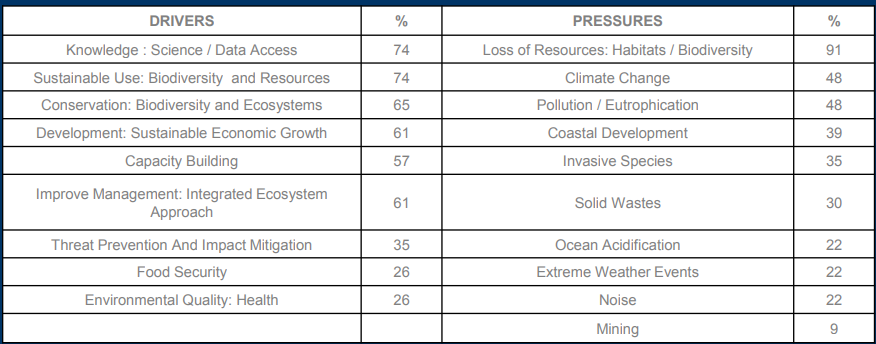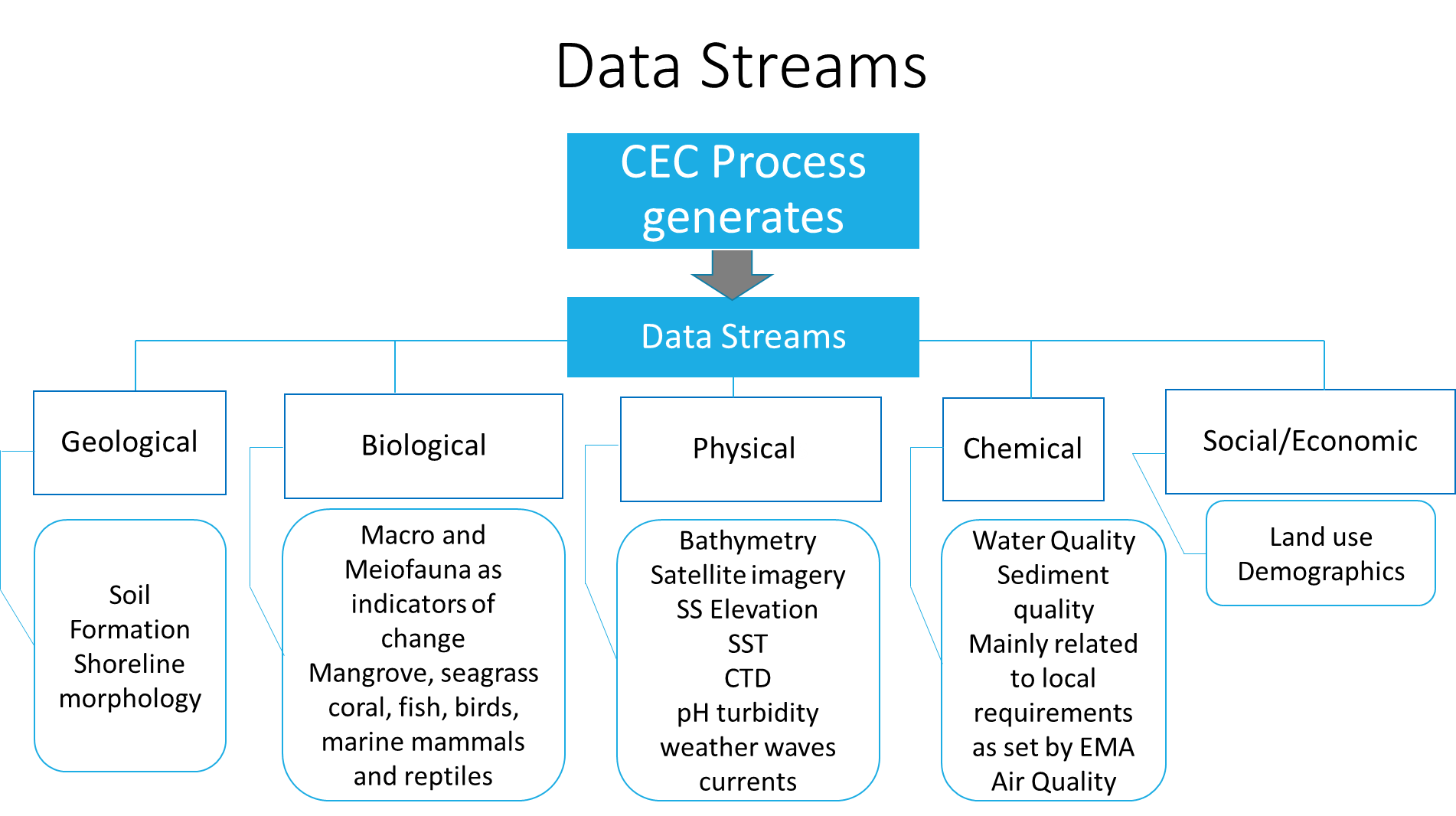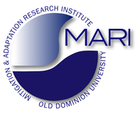Implementing and Monitoring the Sustainable Development Goals in the Caribbean: The Role of the Ocean
Session 4: Observational requirements for ocean-related variables and indicators
Co-Chairs: Francisco Chavez and Emily Smail
The goal of this session was to use the knowledge needs identified in the first two sessions together with applications to create this knowledge in the development of observational requirements for the prioritized ocean-related variables collected in Session 3. The original goal was to have a set of requirements for high-priority variables that specify the spatial and temporal resolution and coverage, accuracy, and latency that are consistent with what those applications require that could make use of the observations. After an initial presentation introducing the “GEO Blue Planet Initiative,” the following four presentations, addressed observational needs in the areas of health and safety, ecosystem health, industry activities, and fisheries. The final presentation provided insight into the role local businesses can play in making progress towards the SDGs.
Presentations
Emily Smail introduced “Oceans and Society: Blue Planet” as an Initiative within GEO that focuses on coastal and ocean observations for societal benefit. She gave a brief overview of a cursory data inventory that had been produced for the workshop and gave examples of a few ocean information products that are used for management and informational purposes. Emily Smail also referenced efforts to develop essential variables for sustainable development that include essential ocean variables, social variables, climate variables and essential sustainable development goal variables. She introduced the speakers who addressed observational requirements various topical areas.
In his presentation “Observational requirements for variables related to human health and safety,” Joaquin Trinanes introduced the NOAA CoastWatch/OceanWatch as program that provides integrated data and tools to scientists and other stakeholders to better understand the physical, biological, and chemical ocean processes. He introduced CoastWatch/OceanWatch products of relevance for the region including:
- ocean acidification product suites,
- tropical cyclone heat potential,
- vibrio monitoring and prediction tools, and
- ocean debris tracking.
He also informed participants about an Ocean Viewer produced by CoastWatch/OceanWatch and the AOML Physical Oceanography Division that provides data visualizations for satellite and in situ ocean and atmospheric data in the region. He added that there is a need for informed public-health decision making and the development of appropriate tools. He stated that the work on vibrio shows what can be done for other species and that there is a need for clinical data reports for vibrio and other marine infections to track outbreaks. He added that understanding how changing environmental factors impact clinical risk for outbreaks is an important focus area for the future.
Cesar Toro summarized “Observational requirements for variables related to ecosystem health.” He introduced IOC as the UN mechanism for ocean science, ocean observations and services, data and information exchange and capacity building. He introduced GOOS as an IOC/UNESCO program that is a sustained global collaborative system for observations, modeling, and analysis of marine and ocean variables to support research and operational ocean services. He added that GOOS coordinates observations across the themes of climate, real-time services and ocean health. Cesar Toro stated that GOOS is working to develop essential ocean variables (EOVs) and currently has a team working to identify biological and ecosystem EOVs based on a Drivers-Pressures-State-Impact-Response (DPSIR) process.
Table 1: Summary of societal drivers and pressures identified and percentage of international bodies addressing each of them.

Table 2. Proposed EOVs for Biology and Ecosystem health of marine ecosystems.

Cesar Toro further introduced the Ocean Health Index, which is a collaborative project between Conservation International, the National Geographic Society, the New England Aquarium, the National Center for Ecological Analysis and the Synthesis and the Sea Around Us project. It is an index that aggregates complex data into a single numerical score for every country. He stated that the Ocean Health index is a tool that can be used for ecosystem health analysis. The audience pointed out that the CLME website is working to provide a baseline for various ecosystems in the region. It was stated that there are other assessments such as the UN World Ocean Assessment and that there needs to be a summary and understanding of what other assessments are doing and where that data can be found.
In his talk on “Observational requirements for variables related to industry activities,” Nazeer Gopaul introduced the main industrial activities in the Caribbean region as oil & gas exploration, port development and operations, marine transportation & trans-shipment, fishing and tourism. He stated that in Trindad and Tobago, the Environmental Management Authority (EMA) operates under a Certificate of Environmental Clearance (CEC) process for industrial activities. He stated that his company, Coastal Dynamics, generates models on waves on currents for use in dispersion modeling for drill cuttings and spill trajectories for clients. He added that there is a need for better monitoring systems for river discharges in the region. The CEC process in Trindad and Tobago produces geological data, biological data, physical data, chemical data and social/economic data.

Figure 1: Overview of the CEC Process.
According to Mr Gopal, the region lacks ground-based measurements for meteorological and oceanographic data. Specific data needs include wind, waves, sea level and river flow. He added that there is also a need to monitor airborne pollutant impacts on the marine environment.
As sources of air pollution affecting ocean systems, Mr Gopal listed:
- Industrial sites
- Agricultural sites
- Marine operations; oil & gas, port, commercial marine traffic and transshipment and bunkering
He identified main parameters of concern:
- Particulate Matter (PM2.5 and PM10)
- Nitrogen Dioxide
- Nitric oxide
- Sulphur Dioxide
- Hydrogen Sulphide
- Volatile Organic Carbons
- Carbon Monoxide
- Ozone
- Metallic Substances (Cadmium and Lead compounds)
- Organic Substances (Formaldehydes and Ethylbenzene)
Mr Gopal stated that for sea level and sea level rise, there is no long-term quality controlled tidal/sea level monitoring system in the region. He added that his company does have an initiative to work on this. He added that some of the major challenges for the region are that the EMA does not share their data and that there is no prescribed standard for data collection or analysis. He outlined the below actions and challenges for data in the region. Local sources of data are available, however,
- there is a lack of standardized methods for data collection, storage and presentation;
- scales are many times not suitable for small scale applications;
- quality control of datasets is often insufficient;
- confidentiality of data and unclear data ownership hampers data sharing;
- limited accessible to public also impacts data sharing;
- enforcement of management plans and policies is needed;
- training and capacity building are required (continuous QA of the data and methodology as staff is not continuous);
- inter-agency and inter-regional collaboration and agreement and execution of policies and goals needs improvements;
- many sources not well known to local users, such as satellite derived data etc.;
- funding from the private and public sectors needs to be encouraged.
He closed by stating that data collection and dissemination needs to be done in a way that is not disrupted during government transition. It was also stated that there are a fair amount of plankton and benthic studies from where the oil and gas companies operate but that this information is not available to the community.
Milton Haughton addressed “Observational requirements for variables related to fisheries applications.” He introduced challenges with marine fish production in countries within the Caribbean Regional Fisheries Mechanism (CRFM). He gave an overview of applicable management plans including the:
- Sub-regional fisheries management plan for flying fish in the Eastern Caribbean;
- St. Georges Declaration on Conservation, Management and Sustainable Use of the Caribbean Spiny Lobster;
- Joint Regional Queen Conch Fisheries Management Plan;
- FAD Fisheries Management Plan (Draft);
- Blackfin Tuna Fisheries Management Plan (Draft).
He stated that the main objective of fisheries management in the region is to achieve maximum sustainable yield. He added that for stock assessments, it is crucial to have data on fisheries landings, independent scientific surveys and biological data. He then gave an overview of oceanographic and socioeconomic data that is needed for ecosystem-based fisheries management.
- Oceanographic:
- Primary production
- Ocean currents
- Ocean temperatures
- Ocean oxygen
- Salinity
- Acidity (pH)
- Nutrients
- turbidity
- Socioeconomics of fishers:
- Education levels of fishers
- Fisher income
- Fixed and operational costs of fishing
Mr Haughton stated that for SDG indicators 14.2.1 (proportion of national exclusive zones managed using ecosystem-based approaches) and 14.4.1 (proportion of fish stocks within biologically sustainable levels) the following information is required:
- 14.2.1
- Percentage of stocks with ecosystem based-fisheries management plans
- Catch and effort data for target species
- By-catch data
- Habitat information- e.g. habitat type, coverage & health – critical fish habitats
- Food webs - Predator prey relationships
- Both the number of species and the distribution of biomass distributed among species
- 14.4.1
- Percentage of countries with national data collection systems
- Number of stock assessments conducted
- Stock statuses known for commercially important species
- Proportion of fish stocks within biologically sustainable limits
- Need to understand population dynamics of stocks [Entry of young fish, growth, mortality, migration]
- Recruitment
- Size composition - Length-weight
- Maturity (rates and weight at age in stock)
- Growth functions
- Fecundity
- Mortality- fishing and natural
- Biomass at age
- Harvest parameters (gear selectivity, catchability)
He closed by giving an overview of challenges that SIDS face for assessing stocks including the high cost of data collection and surveys and limited human and institutional resources. He stated that single species models are difficult and data intensive and that it would be more feasible for countries with limited resources to pursue an ecosystem based approach. He added that to move forward, increased capacity, data sharing and compatibility of data for regional assessments was needed.
In the final presentation, Vaughn Martin talked about “Supporting observations with citizen science and crowd-sourcing.” Mr Martin gave an overview of projects that his dive shop has been involved in including underwater beach clean ups, the installation of wave monitoring equipment on the windward coastline of St. Vincent and the PADI certification of fisherfolk in the region through a livelihoods grant. He added that his dive shop led the “Diving, another way of life” program to certify community college and secondary students.
He then gave an overview of the challenge of the invasive lionfish in the region stating that there is sporadic funding to do derbys to catch lionfish but interest drops when the funding drops. He stated that his dive shop has started a monthly lionfish catch and cookout in coordination with a local restraint (“We have to eat them to defeat them”). Mr Martin closed by giving an overview of some of the major challenges locals are facing in the region:
- Debris flowing into the ocean after heavy rainfall through the river system that exits into the site for the Marine Managed Area.
- Getting the fisherfolks more aware of the damages done to the reef by their nets. Not to mention spearfishing of juvenile fishes especially the parrot fish.
- Lack of resources to police and implement rules and regulation necessary to ensure the success of these projects.
- More information and collaboration needed between key stake holders and government organisations.
This workshop was sponsored by:
 under grant 80NSSC17K0241 |
 |
 |
 |
 |